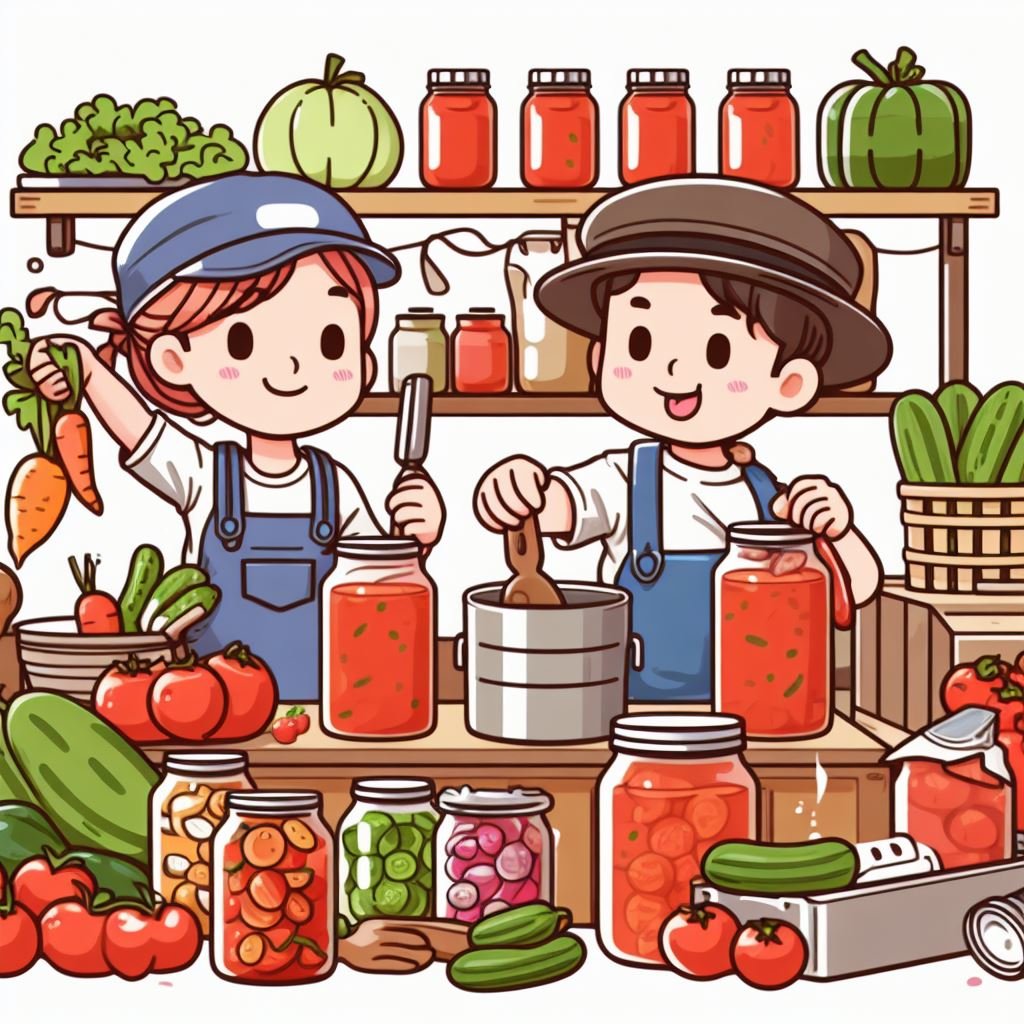Is Canning Worth It? Weighing the Pros and Cons
Canning, a time-honored method of preserving food, has seen a resurgence in recent years. As more individuals seek sustainable and homemade solutions to store their favorite foods, canning has become popular. But what exactly is canning, and why is it gaining so much attention?
Canning is more than just a method of food preservation; it’s a bridge to the past, evoking memories of grandmother’s pickled cucumbers or an aunt’s homemade strawberry jam. One can recreate these cherished flavors right at home using techniques like pressure canning and water bath canning. The process goes just a step beyond regular cooking. It involves sealing food in glass jars and subjecting them to high temperatures. This not only destroys contaminants but also removes air from the jars. As they cool, a vacuum seal forms, ensuring the food remains uncontaminated and fresh for an extended period.
The question that lingers in the minds of many, especially those new to the practice, is: “Is canning worth it?” This article explores the intricacies of canning, its benefits, potential challenges, and its place in the modern culinary landscape. Whether you’re a seasoned chef or just starting your food preservation journey, this guide will provide insights into the world of canning and help you determine if it’s the right fit for you.
Table of Contents
History of Canning
The art of canning has deep historical roots, tracing back centuries. While the methods and tools have evolved, the core principle remains: preserving food to extend its shelf life. The history of canning is intertwined with the need for long-lasting food supplies, especially during war, exploration, and long sea voyages.
In the late 18th century, the French government offered a cash prize to anyone who could devise a method to preserve food for its troops. This led to the invention of a rudimentary canning process by Nicolas Appert, often regarded as the “father of canning.” Appert’s method involved sealing food in glass bottles, which were then boiled to eliminate contaminants. This discovery revolutionized food storage, making it possible to have access to preserved foods year-round.
The process further evolved with the introduction of tin cans, leading to the term “canning.” These cans were more durable than glass bottles, making transportation easier and more efficient. Over the years, the canning process was refined by introducing pressure cookers and other advanced equipment, ensuring better preservation and safety.
Today, canning is a means of preservation and a way to capture the essence of seasonal produce, allowing us to enjoy flavors at their peak, irrespective of the season. Canning has become integral to our food culture, from households to large-scale industries.

Benefits of Canning
Canning, a practice that has stood the test of time, offers many advantages beyond just food preservation. As more individuals lean towards sustainable and self-sufficient lifestyles, understanding the benefits of canning becomes crucial. Let’s delve into the myriad of benefits this age-old method offers:
- Extended Shelf Life: The promise of longevity is the heart of canning. Fresh produce, meats, and dairy products have a limited shelf life. However, when canned, they can be stored and consumed over extended periods, sometimes even years, without compromising their quality or taste.
- Nutritional Retention: A common misconception is that canned foods lose their nutritional value. In reality, the canning process locks in the nutrients at their peak. Vitamins and minerals are preserved, ensuring you get a healthy dose of nutrients every time you open a can.
- Economic Benefits: Think of canning as an investment. While there’s an initial cost for equipment and supplies, the long-term savings are significant. You can bypass the inflated prices of off-season goods by canning seasonal produce when it’s abundant and affordable. Over time, this leads to considerable savings.
- Sustainability and Reduced Waste: In a world grappling with food wastage issues, canning emerges as a sustainable solution. Instead of discarding surplus produce, it can be canned for future consumption. This reduces waste and promotes a more eco-friendly approach to food.
- Flavor Preservation: Canning captures the flavors of foods at their peak. This means that you can relish the taste of summer strawberries or fall pumpkins any time of the year. The process ensures that the essence of the food remains intact, offering a burst of freshness with every bite.
- Convenience: In today’s fast-paced world, convenience is key. A pantry stocked with canned goods means you always have ingredients for quick meals. Canned foods can significantly reduce meal prep time, whether it’s a base for soups, sauces, or a side dish.
- Safety from Contaminants: When done correctly, the canning process eliminates harmful bacteria and pathogens. The vacuum seal on canned goods ensures the contents remain uncontaminated, providing a safe and wholesome eating experience.
In essence, canning is not just a method of preserving food; it’s a lifestyle choice that offers numerous benefits for the individual and the environment.

Types of Canning
Canning is a versatile method of food preservation, and understanding the different types is crucial for both safety and quality. There are two primary methods of canning, each suited to different types of foods based on their acidity levels.
Water Bath Canning (Boiling Water Bath)
- Definition: This method involves submerging canning jars filled with food in a large pot of boiling water. It requires no special equipment beyond the canning jars.
- How it Works: The jars, filled with food and secured with special canning lids, are completely immersed in boiling water for a specified duration. As the jars cool post-processing, a vacuum seal forms, preserving the contents.
- Suitable Foods: Water bath canning is ideal for high-acid foods. This includes fruits, pickled vegetables, sugar preserves, and tomatoes with added acidity (like lemon juice, vinegar, or citric acid). The acidity, combined with the heat of boiling water, ensures safe preservation.
Pressure Canning
- Definition: Pressure canning requires a specialized piece of equipment known as a pressure canner (distinct from a pressure cooker). This method can heat food in jars to temperatures higher than boiling water.
- How it Works: The pressure canner achieves temperatures hotter than boiling water, which is essential for preserving low-acid foods. This high temperature eliminates botulism spores, which can survive boiling water but are destroyed at these elevated temperatures.
- Suitable Foods: Low-acid or alkaline foods must be processed using a pressure canner. This category includes unpickled vegetables, vegetable soup stocks, meats, poultry, and seafood. These foods have a neutral or slightly alkaline pH, making them susceptible to botulism if not processed correctly.
It’s imperative to match the food with the appropriate canning method. Using the wrong method can lead to unsafe preserved foods, posing health risks like botulism. Fortunately, canning can be a safe and rewarding experience with the right knowledge and guidelines.
Safety Concerns in Canning
Safety is paramount when it comes to canning. While the process offers numerous benefits, it’s essential to be aware of potential risks and how to mitigate them. The goal is to preserve food in a manner that’s effective and safe for consumption.
- Understanding the Risks: One of the primary concerns with canning is the potential growth of harmful bacteria, particularly Clostridium botulinum, which leads to botulism, a severe form of food poisoning. The bacteria thrive in low-acid, oxygen-free environments, making canned foods a potential breeding ground if not processed correctly.
- The Importance of Correct Methods: As highlighted by Dr. Elizabeth Andress in an interview with NBC News, many individuals often resort to unsafe practices they find on personal websites. They might “get away with it” once but risk getting sick or making someone ill in subsequent attempts. It underscores the importance of following scientifically backed canning methods.
- Acidity Matters: The acidity level of the food being canned plays a crucial role in determining the safety of the process. High-acid foods, like fruits, naturally inhibit the growth of harmful bacteria. In contrast, low-acid foods like vegetables and meats require higher temperatures to ensure safety, which is achievable only through pressure canning.
- Equipment Maintenance: Regularly inspecting and maintaining canning equipment is vital. Damaged jars, faulty seals, or a malfunctioning pressure canner can compromise the safety of the canned food.
- Storage Conditions: Once canned, storing jars in a cool, dark place is essential. Extreme temperatures or exposure to light can degrade the quality of the food and potentially introduce safety risks.
- Stay Updated: Canning guidelines and recommendations can evolve based on new research. It’s crucial to stay updated with the latest guidelines from trusted sources to ensure you’re following the best practices.
While canning is a fantastic way to preserve food, it’s imperative to approach the process with a safety-first mindset. By understanding the potential risks and adhering to recommended practices, one can enjoy their labor’s fruits (and vegetables) without any worries.
The Modern Take on Canning
The art of canning has evolved over the years, adapting to modern lifestyles while retaining its essence of preserving food. As we navigate through the 21st century, let’s explore the contemporary nuances of this age-old practice:
- Adapting to Modern Techniques: Traditional canning methods have seen updates to accommodate modern lifestyles. For instance, Ball Canning announced in 2014 that home canners no longer need to sterilize or heat canning lids due to the modern plastisol sealant. This change simplifies the process, making it more accessible to today’s generation.
- Flavor Preservation: One of the standout features of home canning is its unparalleled flavor. Even with high-quality organic produce in stores, home-canned goods often surpass them in taste. The freshness of homegrown produce, combined with immediate processing, locks in a flavor that’s hard to replicate.
- Economic and Environmental Benefits: Canning at home saves money and reduces the carbon footprint. By preserving locally grown produce, one minimizes the need for transported goods, leading to a more sustainable food consumption pattern.
- Convenience and Variety: Modern canning is all about convenience. Whipping up a meal becomes a breeze with a pantry stocked with various home-canned goods. From tomato-pinto bean soup to strawberry applesauce, the options are endless. Moreover, unique items like organic ‘Orange Banana’ tomatoes or raspberry fruit butter, which might not be readily available in stores, can be enjoyed year-round.
- Safety First: While the methods have evolved, the emphasis on safety remains unchanged. Safety is paramount, whether it’s understanding the difference between high-acid and low-acid foods or ensuring the right canning equipment. Modern resources, such as the National Center for Home Food Preservation, offer updated guidelines to ensure safe canning practices.
- Equipment Evolution: While the basics remain the same, there have been advancements in canning equipment. Modern canning jars with two-piece metal lids are recommended over old-style jars with glass dome lids. Additionally, pressure canners have become more sophisticated, ensuring consistent pressure and safer canning.
While the essence of canning remains rooted in tradition, its adaptation to modern times ensures it remains a relevant and cherished practice. Whether you’re a seasoned canner or a newbie, the modern take on canning offers a blend of tradition and innovation, making the process both enjoyable and rewarding.
Final Thoughts
Canning, a culinary art spanning generations, offers a unique blend of tradition and modernity. As we’ve journeyed through its history, various methods, safety protocols, and its place in today’s world, one thing remains clear: canning is more than just a method of preserving food. It’s a testament to our desire to capture the essence of nature’s bounty, to relish flavors beyond their season, and to create lasting memories with every jar.
The question, “Is canning worth it?” is subjective and varies from person to person. For some, the joy of savoring home-canned goods, the satisfaction of self-sufficiency, and the economic benefits make it an unequivocal ‘yes.’ For others, it might be the allure of sustainability or the sheer pleasure of crafting something with their hands.
Ultimately, canning is a personal journey that requires patience, knowledge, and a touch of passion. Whether you’re a seasoned pro or a curious beginner, the world of canning awaits, promising a delightful blend of flavors, memories, and experiences.






